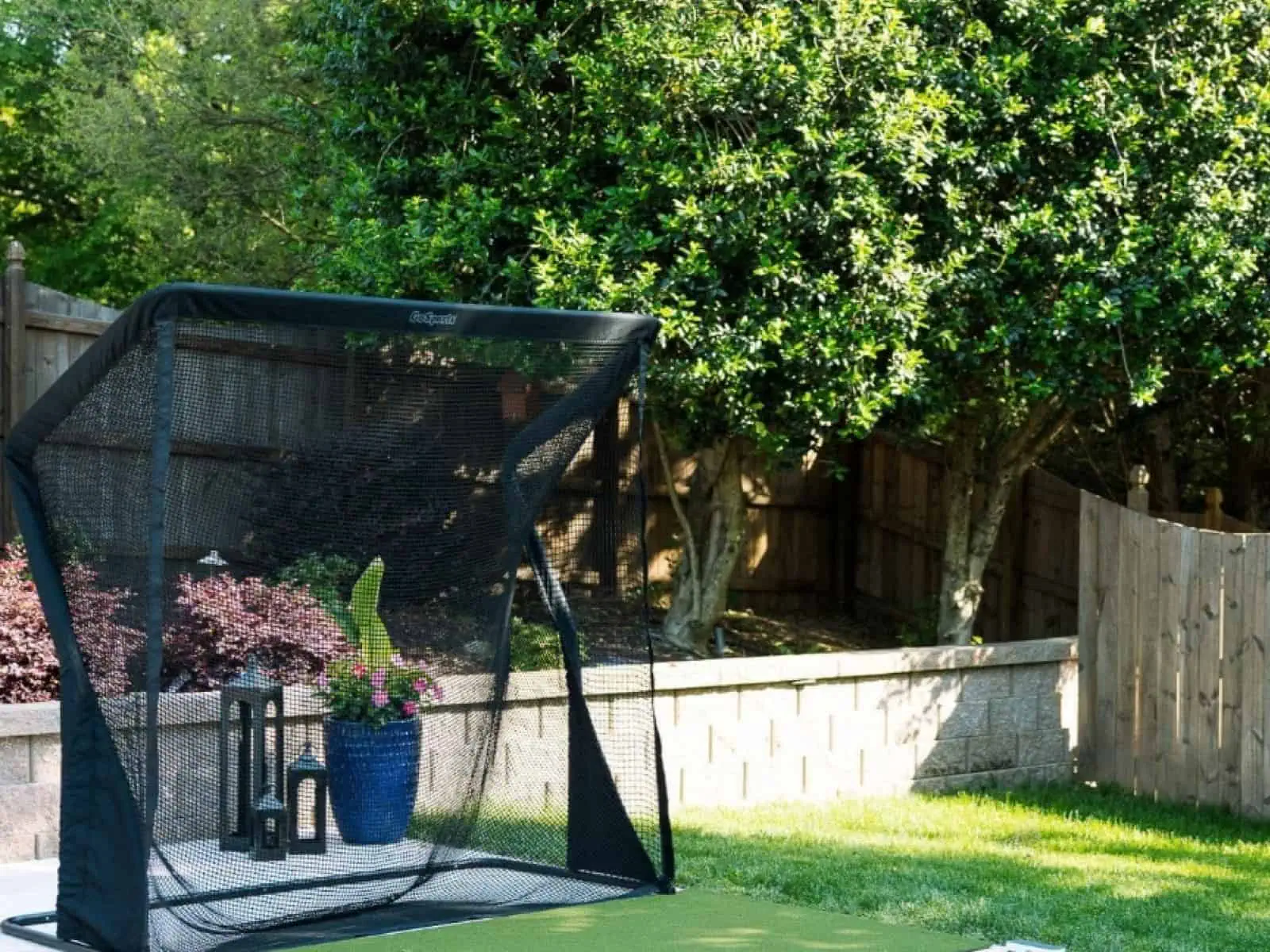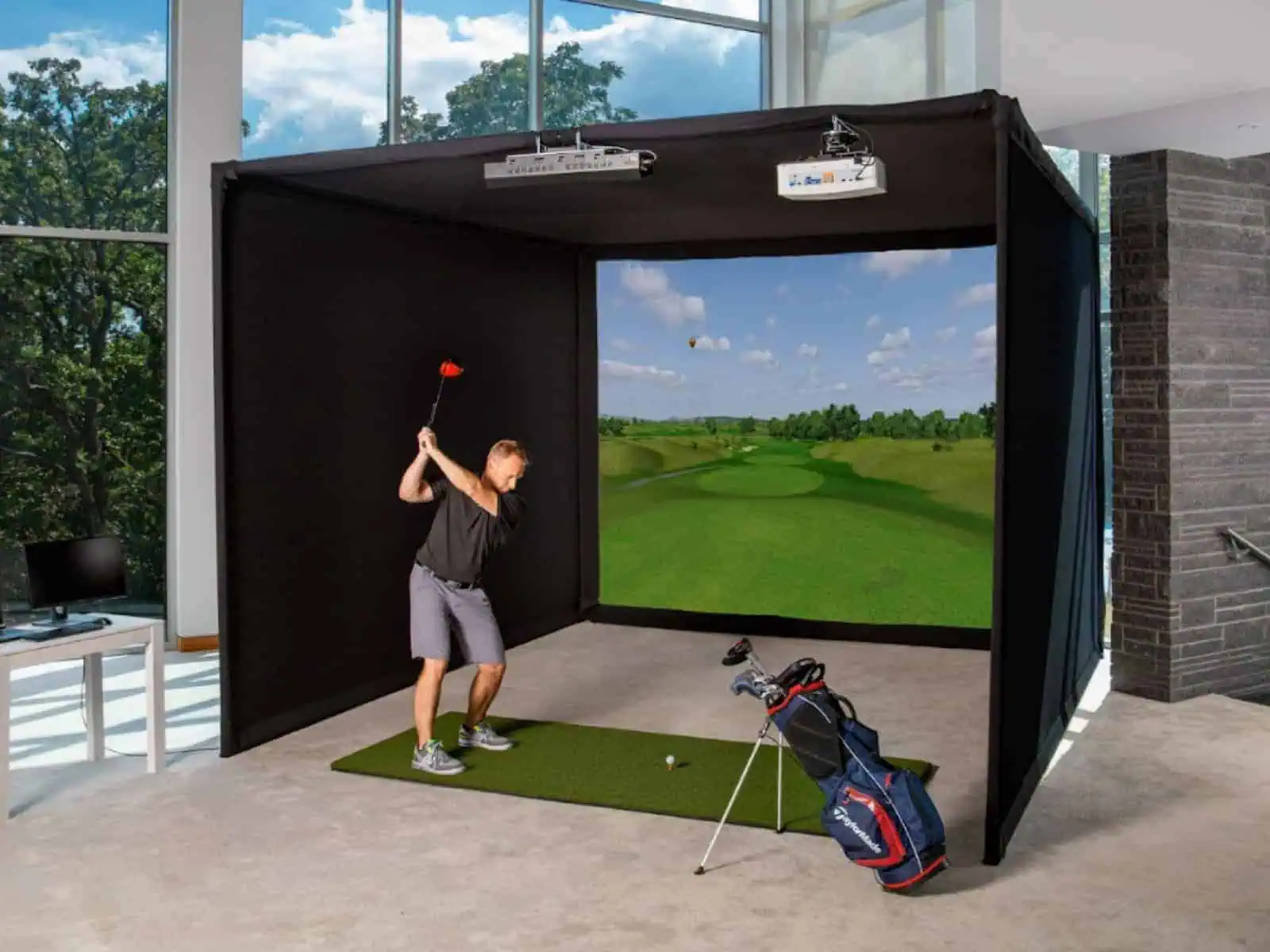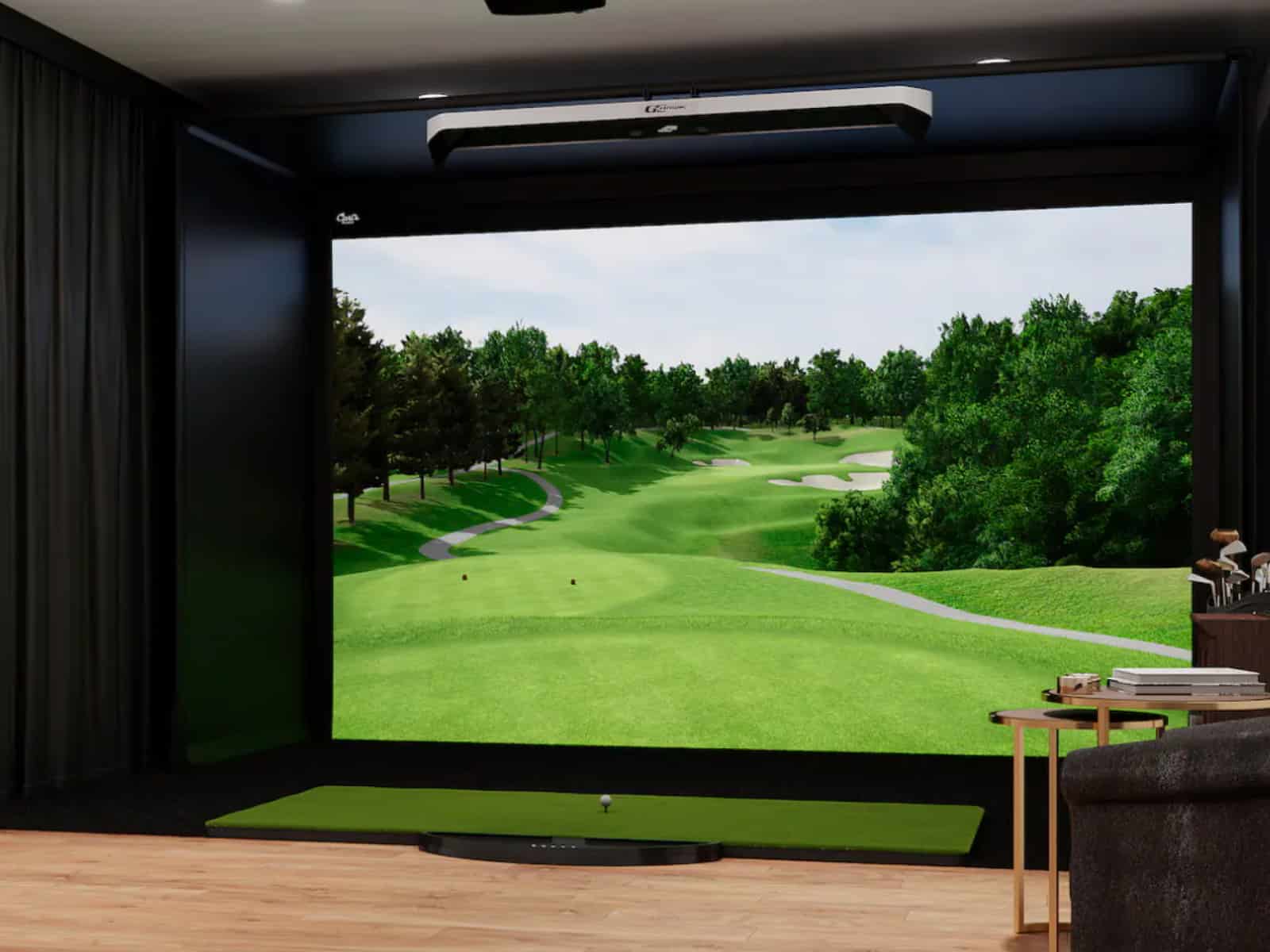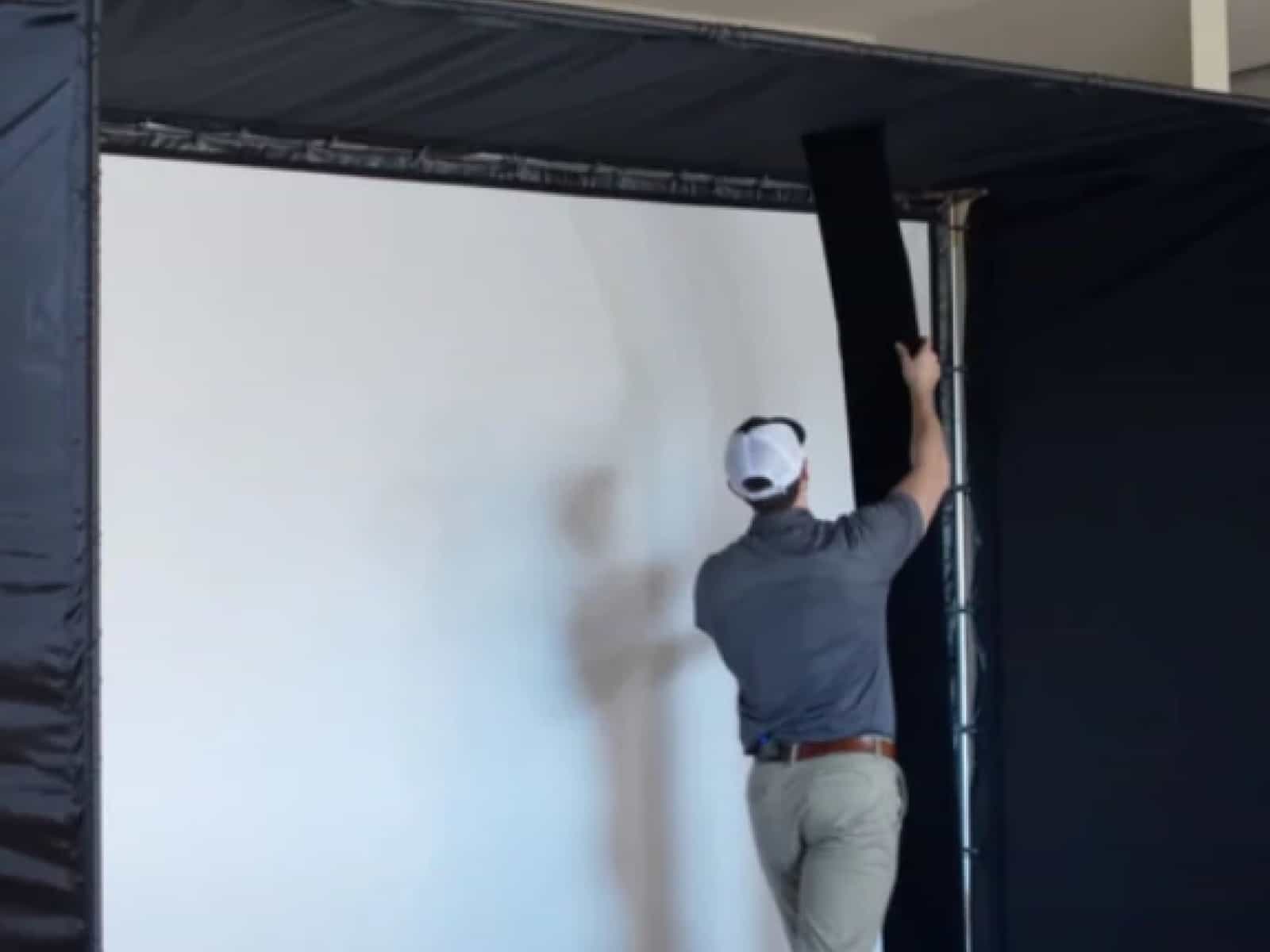A key component in any golf simulator configuration is selecting the appropriate hitting net that you actually strike the golf balls into. The hitting net needs to be durable enough to withstand repeated ball impacts, while also having the appropriate dimensions and features to suit the available space. Carefully selecting the right hitting net is crucial to get the most life-like experience fine-tuning different golf shots indoors.
This article provides an extensive outline of the vital considerations when selecting a hitting net for your personal or commercial golf simulator setup. The forthcoming chapters will explore the different types of hitting nets available.
By learning about these facets of golf simulator hitting nets, you will be equipped with the knowledge to choose the ideal setup to match your budget, room dimensions and overall simulator requirements.
Types of Hitting Nets
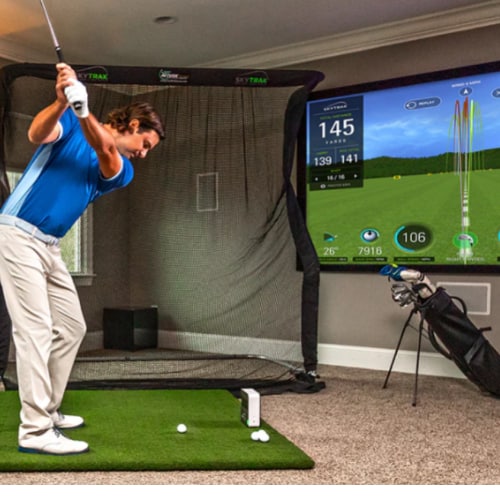
When shopping for a golf simulator hitting net, one of the first decisions is which style or type of net structure best suits your requirements. There are a few main options on the market:
Fully Enclosed Golf Simulator Nets
Enclosed net bays provide full 360-degree ball containment, with netting encapsulating the complete area. The main benefit is protection – the thick layered netting prevents balls from spraying and damaging walls, monitors or other equipment. Enclosed bays are ideal for multi-player commercial simulator installations.
The downsides are they are more expensive and often require professional installation, attaching mounts to the ceiling and walls. Permanent mounting also means enclosed nets are not portable if you change residence. But for ultimate safety and durability, enclosed simulator nets are the premium choice.
Open Hitting Nets
Open hitting nets feature a simple rectangular netting structure, either freestanding or attached to side poles. Less netting material makes them cheaper and easier to install than enclosed nets. Open nets are a sensible budget choice for personal simulators.
Without side netting, however, open nets require safety netting on adjacent walls to prevent missed shots. And any monitors/equipment behind the hitter needs adequate distance. Check the product dimensions carefully in relation to your room space.
Portable Golf Practice Nets
Portable practice nets offer great versatility for limited spaces. Available as folding nets with retractable poles, they set up and pack down quickly as needed. Being movable means storage is easy when not in use.
The trade-off is portability affects ball containment compared to permanent nets. Side netting is minimal on most portable nets, so they are really best for solo use chipping or hitting straight shots rather than angled hooks/slices. For small multi-purpose rooms though, portable nets provide nice flexibility.
In determining the best hitting net type, weigh factors like budget, portability needs, available space and any protection considerations in your simulator room. This guides you to the right style suiting your objectives.
Netting Material and Durability
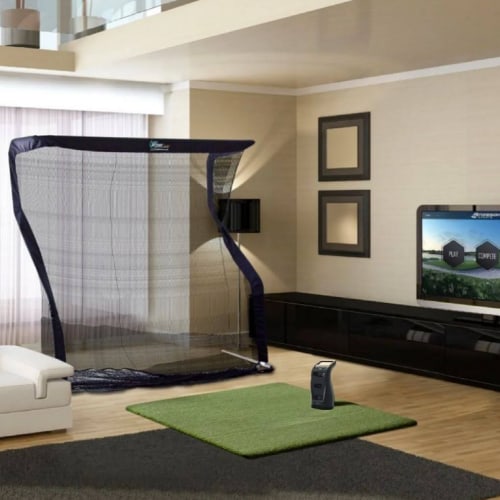
The netting material and durability should be one of the key considerations when researching golf simulator hitting nets. These factors have a direct impact on ball containment, stoppage and the net’s longevity withstanding thousands of golf ball strikes over time.
Weather Resistance
The type of net material required depends firstly on whether it will be situated indoors or outdoors:
Outdoor Hitting Nets: Due to increased exposure to elements like sunlight, rain and wind, outdoor nets require vinyl or UV-resistant coatings. Look for products advertising “weatherproof” netting, using high-denier polyester that is built to handle years outdoors without degrading.
Indoor Nets: For indoor use protected from weather, regular polyester or nylon netting will generally suffice. Without UV exposure, cheaper options can withstand thousands of strikes in a typical climate-controlled indoor golf simulator.
Abrasion Resistance
Durability ratings give assurance on the net’s longevity, usually denoted by the denier measurement. Higher denier materials can handle more friction and golf ball abrasion without rapidly forming holes or tearing compared to low denier (600D or less). Many golf hitting net products will state a “lifespan” expectation, typically from 500,000 to 2 million strikes, depending on ball speed.
Look for heavy-duty netting of 1000D+ denier for simulator bays. For lower-use practice nets, around 900D gives a decent lifespan if not using the fastest club/ball speeds. Checking durability ratings gives confidence your purchase can sustain years of an intense golf regime.
Attachment Points
Attachment points like top/bottom bands, rings or Velcro are also important for durability. Solid, well-designed upper/lower anchoring prevents the net from drooping in the middle over time, maintaining ball containment ability. Poor attachments lead to loosening, further straining netting material causing premature aging. Quality installation fittings tremendously help longevity and functionality.
In summary, checking the weatherproofing, denier ratings and reviewing attachment points ensures you buy netting able to sufficiently withstand abrasion from your golf ball strikes over many simulator seasons. While premium netting costs more upfront, it helps reduce replacement costs from prematurely torn nets down the track.
Frame and Installation Options
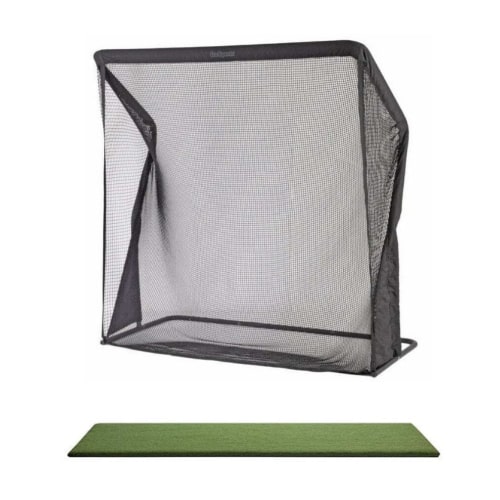
The frame structure and installation process differ depending on the type of golf hitting net.
Permanent Enclosed Golf Simulator Nets
Fully enclosing a space requires substantial mounting braces into the ceiling and perimeter walls. Enclosed net frames use metal tubes or tensioned cables, secured by solid brackets. This ensures the structure stays firmly in place despite thousands of impacts.
Due to the extent of mounting, enclosed bays usually need professional installation. Permanently affixed nets also mean that if you change residence, the hitting net stays behind.
While costly, enthusiasts wanting dedicated multi-player simulator rooms view professional enclosed net construction as a sound investment matching other high-end simulator components.
“Quick Install” Hitting Nets
Alternatively, some open net products advertise quick and easy self-installation. Rather than permanently mounting to surfaces, these nets use free-standing frames with weighted leg bases. Fastening straps then tension the net upright.
If needed, the movable design means taking the net down again is straightforward. This appeals to rental spaces or temporary setups. Just ensure there is still adequate protection behind the net if missing left or right.
Outdoor vs. Indoor Positioning
Outdoor hitting nets must withstand wind, rain and other weather elements. So durable construction is vital – using robust, weatherproof netting or stronger, grounded frames. Check weather rating specs before purchasing an outdoor net.
Indoor nets simply need sufficient room for the frame footprint and swing clearance. Focus is more on maximizing available space, rather than withstanding seasons outside. Just always observe basic safety clearance from the walls.
Additional Features and Accessories
Beyond the core net and frame, extra accessories can enhance hitting nets with supplementary functionality. For a comprehensive review of enclosure options to contain golf shots, check out our guide on golf simulator screens and enclosures. The following are some accessories you can get with your golf net.
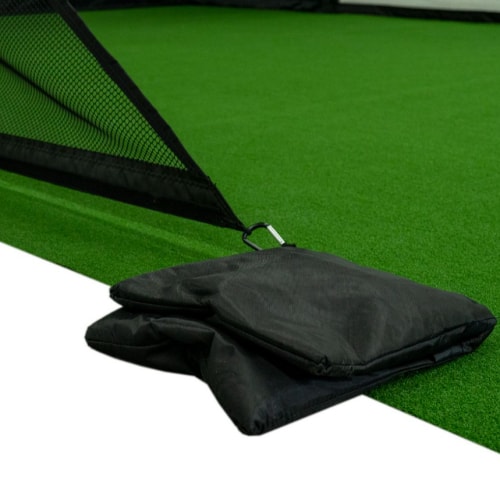
Side Netting Panels
Side panels featuring netting down the left and right sides help contain mis-hit shots spraying wayward. Preventing these errant balls from hitting walls keeps the simulator room safer.
Side panels suit setups hitting angled, shaped shots – not just straight drives.
Ball Collection Nets
Collection nets catch balls neatly at the bottom of the main net, gathering them ready for the next shot rather than being scattered on the floor. These are helpful for multi-player simulator bays hitting lots of balls in rapid succession. They also prevent tiring excessive bending to pick up balls.
Golf Hitting Mats
Quality hitting mats simulate different lies and conditions – fairway, rough, bunker, uphill, etc. Variable textures also affect club interaction.
Some nets come with a main mat included, though additional lie options create further realism. Also, authentic feedback fine-tunes shot refinement.
Side Curtains
Side curtains block lateral distractions in periphery vision which may subconsciously affect your swings. They allow you to focus on the ball and target area ahead, ignoring your surroundings. In addition, the curtains help with concentration for improvement drills requiring precision.
Consider if any accessories can directly improve your practice experience. Assessing needs against budget helps strike the right balance of any “nice-to-have” upgrades beyond the basic hitting net itself.
Frequently Asked Questions
The following is a list of the most widely asked questions answered to help you know everything about golf nets and choose the perfect option for your needs and preferences.
What size net do I need?
The required hitting net dimensions depend on factors like your room size, number of players, and type of shots being practiced (full drives vs short game). As a general guide, allow at least 8′ x 8′ for solo practice. Enclosed bays typically range from 12′ x 15′ up to 20′ x 25′ for ultimate flexibility.
Is professional installation recommended?
For permanent enclosed nets, professional installation is usually advised to securely mount into the ceiling and walls.
Freestanding open or portable nets can be simpler DIY projects if you follow the included instructions carefully. Getting measurements right is key.
What features help recreate real golf course conditions?
Variable lie hitting mats simulate different textures for realistic club interaction. Side nets catch extreme slices/hooks. Curtains narrow focus while slope/speed modules adjust simulations for uphill, downhill and faster/slower greens.
What ongoing costs are involved?
After the initial hardware investment, main costs are personal or commercial simulator software/game license fees. Clubs and balls wear over time, while broken netting or mats may need replacing after extensive use. Still, good-quality simulators can provide years of reliable performance.
Where can I find reviews and comparisons?
Well-known golf publications like Golf Digest and Golf Magazine provide impartial simulator reviews and buying advice. There are also dedicated simulator review websites detailing leading home and commercial system options. YouTube demos also showcase the gameplay experience.
Do I need insurance cover for my home simulator?
It’s recommended. Consult your homeowners’ insurance provider on coverage for potential damage from missed net shots. Commercial simulator bays require dedicated business insurance policies. Documentation helps if any liability issues arise.
Final Thoughts
Carefully considering the choice of net type, durability, frame installation, and accessories allows configuring the ideal golf simulator hitting net for your needs and budget. Quality netting designed to withstand years of ball strikes pays dividends over time.
For more specific details on the options currently available on the market, check out our guide to the best golf simulator nets.
For commercial bays, reservation fees quickly offset setup investments, while personal systems enable practice from home. Homemade or rented simulators with sturdy hitting nets provide excellent ball flight visibility that outdoor ranges often cannot match. This captures accurate data to gradually develop your swing.
So invest wisely in an appropriately sized and spaced hitting net aligned to objectives. Then enjoy entertainment and skill refinement alongside friends, family or solo.
For those interested in building their own golf simulator at home, our DIY golf simulation creation guide covers everything from planning to construction to operation.
If you have any questions, feel free to contact us.
Thanks for reading!


